Brief

1. The cost of distance as disruptive force
For centuries, the cost of distance has determined where businesses produce and sell, where employers locate jobs and where families choose to live, work, shop and play. What if this cost fell dramatically, thanks to new technologies? How would the global economy change if manufacturers could produce locally in small batches, without incurring excess cost? Would existing business models and supply chains, for instance, suddenly become uncompetitive? If people could work from anywhere, would crowded neighborhoods start to thin out?
That change already has begun in the world’s advanced economies and is gathering momentum. Over the next two decades, the cost of distance will decline sharply, according to Bain research, altering the way we live and work—faster than most people expect and more broadly than many imagine. This next big economic shift will create an astonishing array of opportunities for businesses and investors—and unexpected risks.

Macro Trends Insights
Demographics, automation and inequality could dramatically reshape our world in the 2020s and beyond. Our insights discuss how executives can prepare for the new global economy.
The catalyst for this historic shift is an array of new platform technologies that have pushed the cost of distance to the tipping point. Multibillion-dollar investments in robotics, 3-D printing, delivery drones, logistics technology, autonomous vehicles and low-Earth-orbit (LEO) satellites are giving rise to new products and services that sharply erode the cost of moving people, goods and information. As these technologies combine and converge, change will accelerate.
For leaders steering companies through this transition, the change will feel turbulent and unfamiliar. Risks will multiply for industries of all kinds. As the very nature of growth shifts, some of the underlying assumptions of existing business models may no longer be valid, leaving many companies with assets stranded in the wrong locations or with businesses that are becoming obsolete.
Growth opportunities, in particular, will shift dramatically. Today’s high-growth emerging markets, the main focus of business investment for over a decade, are likely to struggle. In contrast, advanced economies will have the potential to embark on a period of sustained expansion.
The cost of distance, or spatial economics, is a critical calculation for businesses and individuals (see Figure 1). Distance can inhibit business growth by making it more expensive to ship a product, for example, or less convenient to visit a store location. To date, the simplest way to reduce the cost of distance has been to use less of it. Cities are monuments to spatial economics—dense urban hubs that minimize the cost of moving raw materials, labor and finished goods.
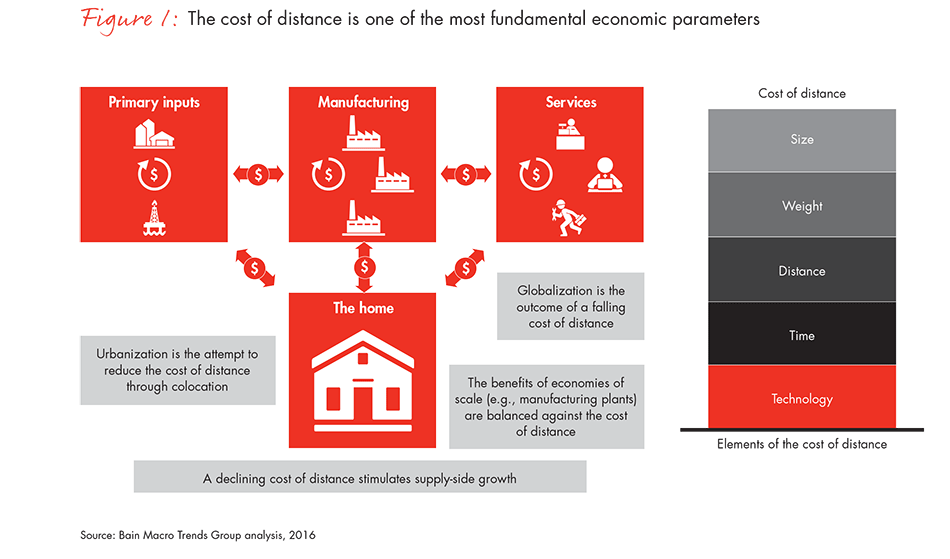
A significant change in the cost of distance would prompt millions of economic actors to rethink their strategies and investments, and cause individuals to reassess where they work, live and raise their families. The costs of moving goods, raw materials, people and information—all are declining, with some items already in a steep and rapid descent. Think about the cost of sending an email compared with sending a letter or a telegraph. Package delivery rates could fall by a similar order of magnitude over the next five years, and we expect advances in vehicle automation over the next decade to sharply reduce the cost of moving people.
Distance is related to both density and scale. Business owners know that the minimum retail shop size to turn a profit is linked to the population density within a given radius. A 6,000- to 8,000-square-foot Apple store, for example, requires a population of roughly 2 million within its trade radius to reach target profitability. The industrial revolution created similar dynamics 200 years ago for manufacturers and other large employers, concentrating workforces to support large-scale production. Now, advanced economies are primarily service-based, but living patterns are still highly concentrated and ripe for disruption.
Over the next decade, the declining cost of distance will release those age-old constraints, making new combinations of distance, density and scale economically viable. Individuals may opt to live further from city centers, for example, as advances in transportation and connectivity allow them the abundant space of a rural town combined with many of the employment options, goods and services once available only in cities (see Figure 2).
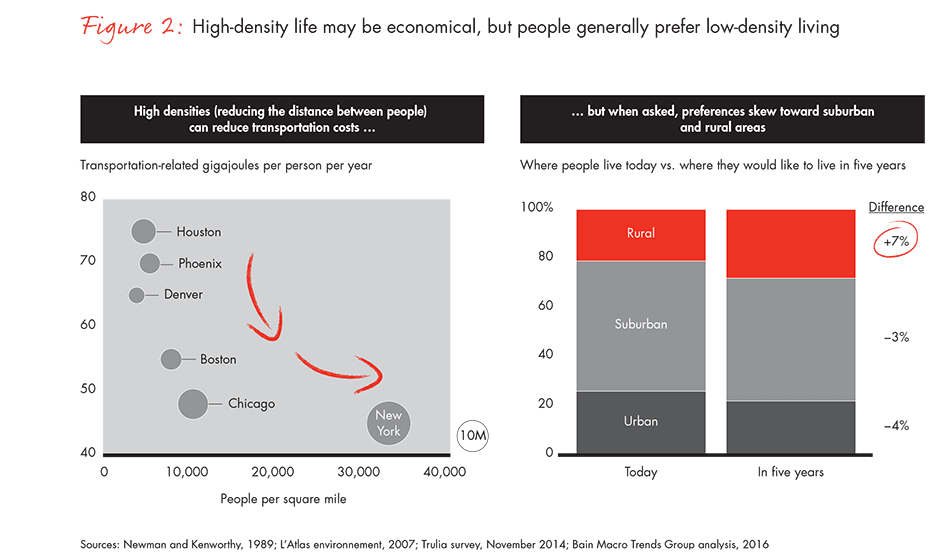
At the same time, many cost-based constraints on businesses will diminish, creating new opportunities. Advances in technologies such as robotics and 3-D printing will allow companies to run small, efficient manufacturing units closer to the customer, tailoring products more quickly to evolving local tastes. Alternatively, firms may outsource the final production of goods to neighborhood 3-D printers. As they embrace these technologies, companies will become less dependent on concentrated workforces to optimize production.
By 2025, we see the US and other technologically advanced countries at the forefront of defining a new post-urban economy. Spatial economics will give rise to new markets, more innovative businesses, new lifestyles and different career opportunities. The coming transformation, like every period of change, will also bring risks and dislocation. One of the wrenching changes will be the loss of what could be many millions of jobs in the service sector in the 2020s as capital replaces labor on a large scale.
In the midst of business-model upheaval, converging technologies will accelerate change and increase the odds of business failure. The challenge will be particularly daunting for heavy-asset industries like manufacturing and infrastructure industries like telecommunications, which make long-term bets on geography and location. Locations that once looked prime may suddenly be worth far less in the coming decade as the cost of distance declines. Today, for example, investors buy land for warehouses strategically located near major roads. But what if proximity to major throughways weren’t necessary in the future, and what if the cost of a plot of land a few miles away drops to half the price? For companies operating under those conditions, the risk and costs of developing stranded assets are highest.
To prepare for a post-urban economy, forward-looking companies are examining the implications for their own industries. Four early actions can help leadership teams keep one step ahead of the coming transformation: Evaluate the risk of developing stranded assets; review supply, distribution and logistics chains with an eye to stripping out distance costs; incorporate new technologies into existing workflows to test and learn; and anticipate the migration of human capital and talent.
At the same time, companies can canvass the growing number of investment opportunities already taking shape as the cost of distance declines. Breakthroughs in transportation technology, for example, will be critical to developing a new generation of goods and services adapted to spatial economics. That includes last-mile logistics, driverless vehicles and the technologies and components that support those sectors. By investing in cutting-edge platform technologies of all kinds, first-movers can lead the coming transformation instead of being caught off guard by change and struggling to adapt.
No one can predict the exact evolution of economy and society as the cost of distance declines. Much will depend on the speed of technological change and the confluence of breakthroughs. However, one thing is clear: Spatial economics will shake up long-held assumptions about economies of scale and opportunities for growth in ways both expected and unexpected. This report lays out the visible changes underway and extrapolates what’s to come in a world in which distance costs far less.
2. The catalysts for change
Three key changes underpin the new economics of distance: Small-scale production of goods and provision of services will become more efficient; high-speed connectivity will become ubiquitous; and the cost of physical transport will fall sharply (see Figure 3).
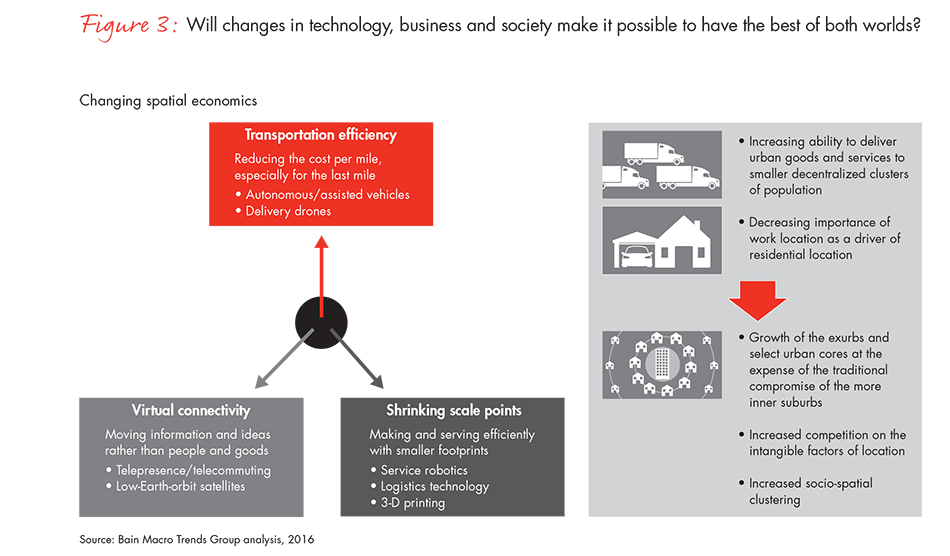
As new technologies eclipse the cost of distance, many industries will discover over the next decade that they are able to operate at a scale and scope that was previously unprofitable. Sophisticated logistics and the declining cost of delivery to the last mile will enable new services and new business models. Mobility, telecommuting and new ways of working, like cloud-based collaboration, will raise the productivity of working at a distance. That combination will give rise to a broader scope of niche services available in remote locations.
Here’s a closer look at the coming changes.
Scaling down: Small-scale production and services become highly efficient
As the cost of distance declines, companies will be able to deliver economic output at smaller scale. Advances in service robotics, 3-D printing and logistics technology already are beginning to lower costs in manufacturing and service, allowing both to be profitable at reduced scale, including batches of one. Automation of many tasks by service robots could lead to a sharp reduction in the minimum efficient scale for many businesses, especially those providing consumer-oriented services, as two examples in casual dining and retail illustrate (see Figure 4).
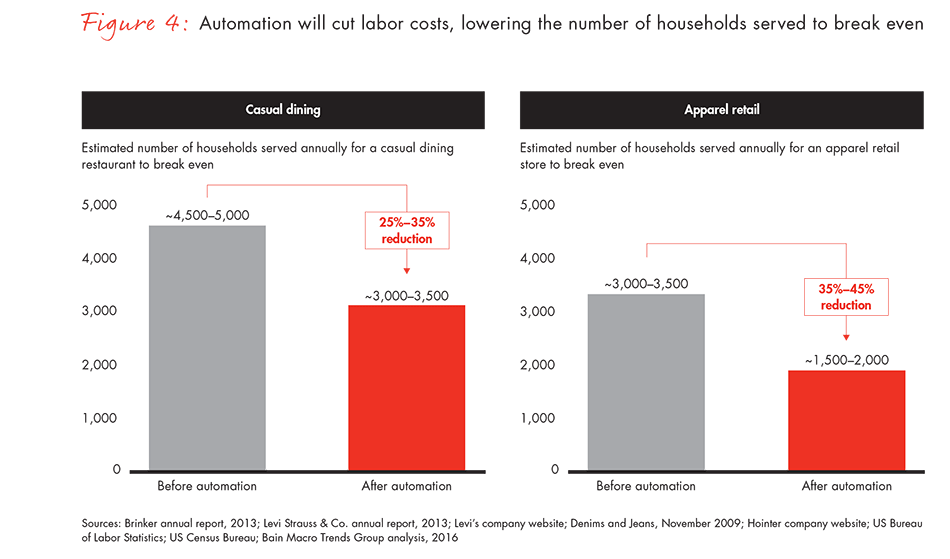
By 2025, for example, service robots deployed by casual dining outlets will be able to reduce by 30% the minimum number of households served annually to break even, according to research by Bain’s Macro Trends Group (see Figure 5). Deploying service robots would also allow a typical casual dining outlet to reduce staff from 25 to 7 or 8 people, trimming wage costs by 40% to 50%. That substitution of capital for labor will allow increased levels of goods and services in towns with lower population densities, making it economically attractive to offer more amenities of city living to country dwellers.
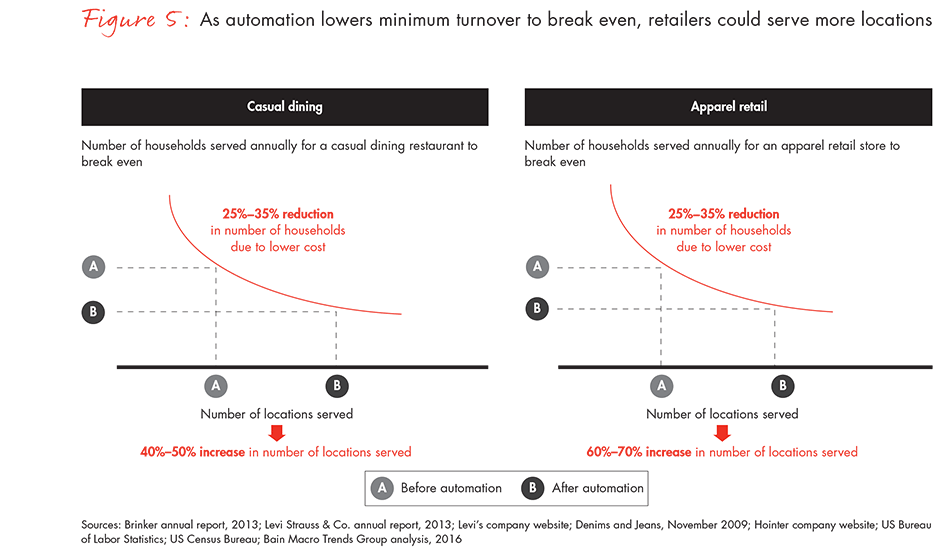
Advances in robotics will also push the boundaries of substituting capital for labor. Breakthroughs in cost-effective robotic dexterity and cognition over the next decade should enable robots to navigate without collision, comprehend voice instructions and interpret their surroundings. We anticipate the first affordable human assistant prototypes will hit the market by the mid-2020s at a cost of around $30,000 (in today’s dollars)—roughly the price point of a new car—down from $300,000 today (see Figures 6–8).
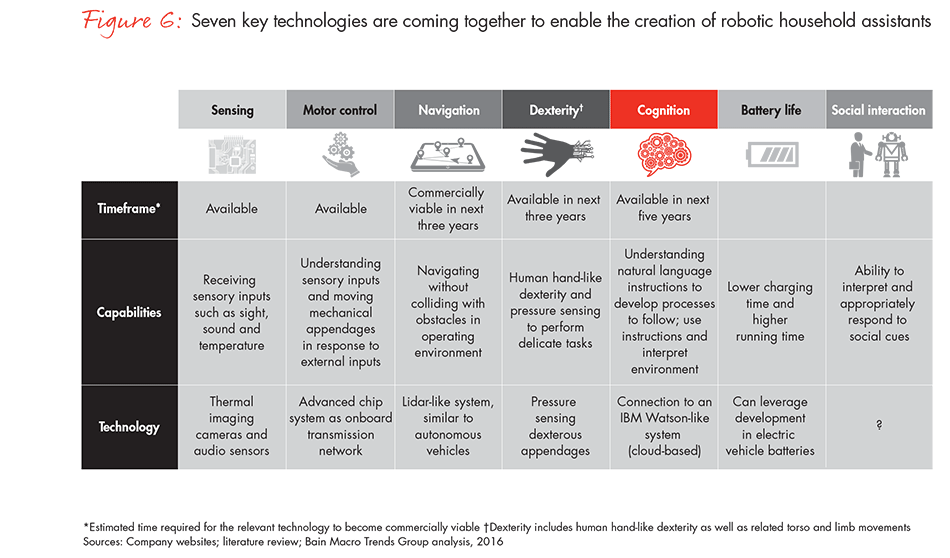
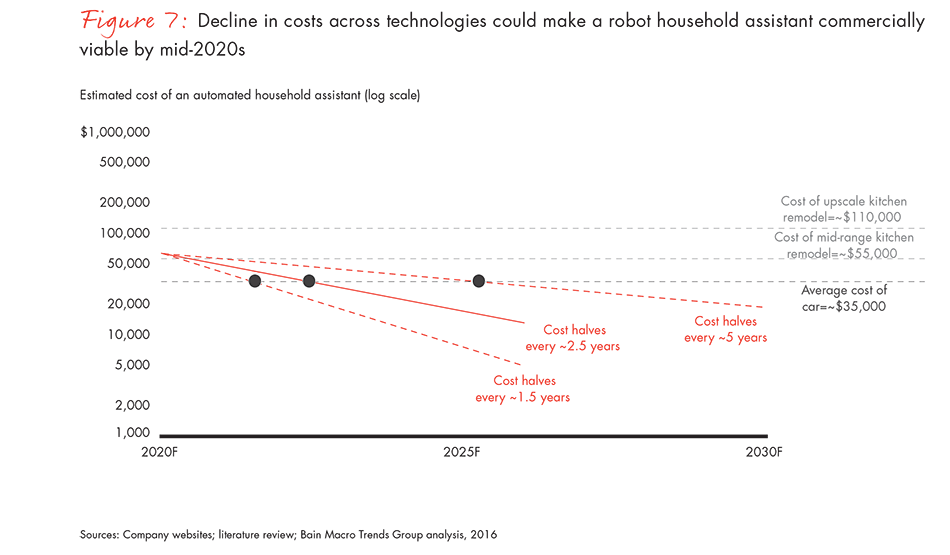
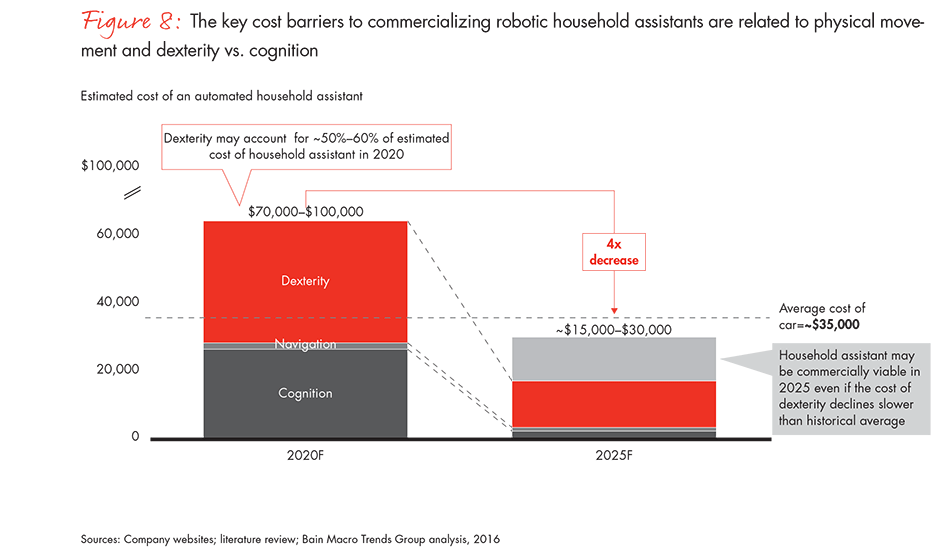
Henn-na Hotel, a 72-room hotel based in an eco-friendly future city theme park in Nagasaki, provides a glimpse of what may become commonplace in a little more than a decade. Using robots as receptionists, porters and concierge, the $80-a-night hotel operates with very little staff.
Additive manufacturing, or 3-D printing, already is eroding the cost of distance by allowing local production of standard parts and complex one-off items, reducing the need for central manufacturing and warehousing. Storing designs electronically and using a standard set of printer substrates to build products eliminates the need for large warehouses while increasing the variety of parts smaller units can inventory. That development presages a shift to smaller warehouses near end users and away from huge storage depots on cheap land near major transportation arteries.
Applications of 3-D printing have become increasingly sophisticated and now rival traditional manufacturing processes. As costs come down, 3-D printing will accelerate the growth of local manufacturing, which looks likely to take off around the start of the next decade (see Figure 9). Already, UPS offers a 3-D printing service at 60 store locations across the US, where customers can print a self-designed custom iPhone case, an architectural model or a functional prototype.
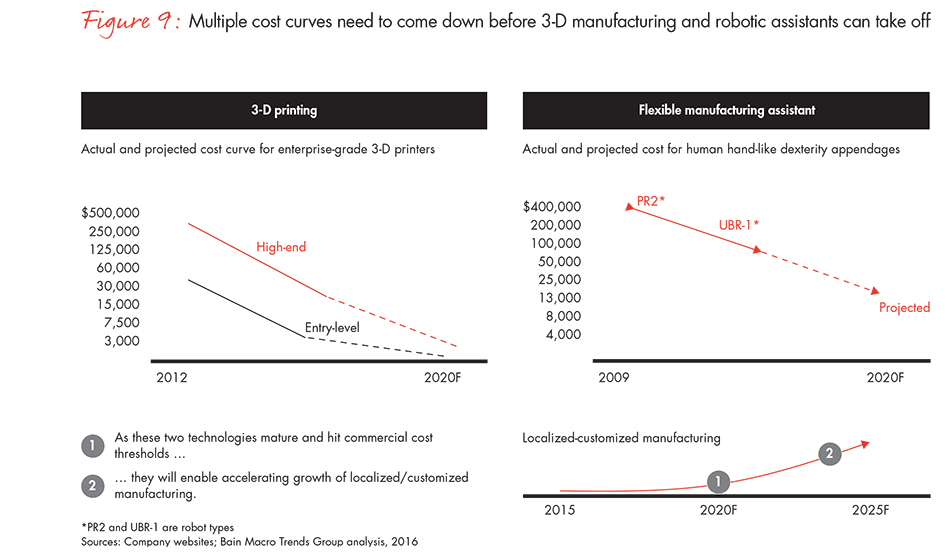
Reduced economies of scale and scope, in turn, will open up opportunities to live in more places. Companies may opt for smaller manufacturing units that are closer to the customer, so they can tailor products more quickly to evolving local tastes. Alternatively, they may outsource the final production of goods to neighborhood 3-D printers. Today retail stores and restaurants require significant scale to be economically viable. With service robotics, an Apple store will potentially be able to thrive in a population center with 200,000 inhabitants instead of 2 million, and a restaurant with a breakeven trade radius of 50,000 may lower the bar by a third or more.
Connectivity: No household left behind
In the post-urban economy, companies will push the boundaries of moving information and ideas, rather than people and goods. New business models will arise around the race to substitute part of all of a physical item with digital equivalents. Why pay to move something physically if you can transmit something virtually for free? Some existing trends will accelerate, such as telecommuting. As millennials become a dominant share of the workforce this decade, physical freedom and increased online skills will add to the momentum for telecommuting. Already 37% of US workers say they telecommute or have done so in the past (on average, two days per month), up from 30% in 2008 and 9% in 1995.
By 2025, Bain forecasts, Americans will require Internet connectivity at 100 Mbps to meet their digital demands, either through cable or fiber optics (see Figure 10). The US is well behind many advanced economies, ranking 12th in the world in download speeds vs. No. 1-ranked South Korea, which has speeds around three times as fast. However, as demand for high-speed Internet grows, lower-density areas will attract innovation in broadband platforms, chiefly aerial broadband technologies. High-powered fixed-wireless solutions or LEO satellite systems are likely to cover lower-density areas with options for higher speed access where fixed solutions (cable, fiber) are not economical, though Bain expects fixed solutions to cover more than 90% of the market by 2025 (see Figure 11).
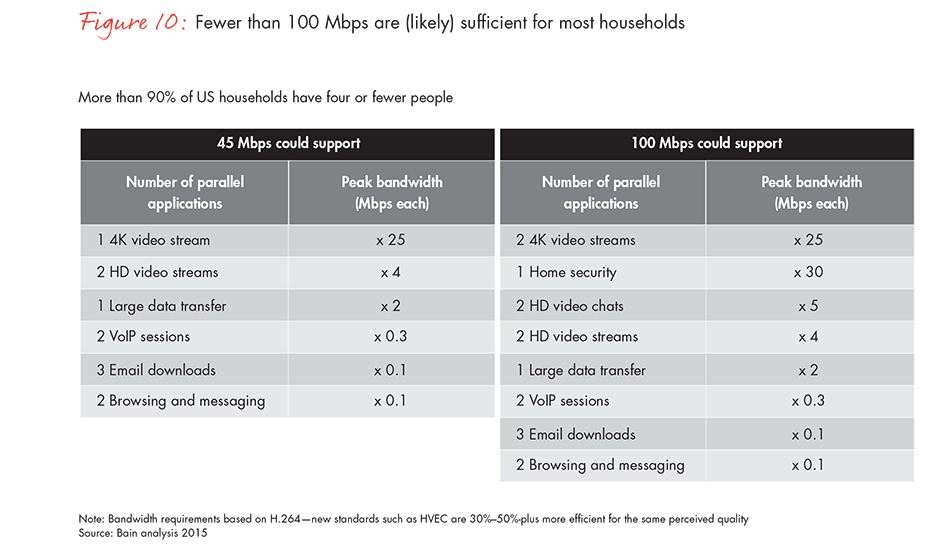
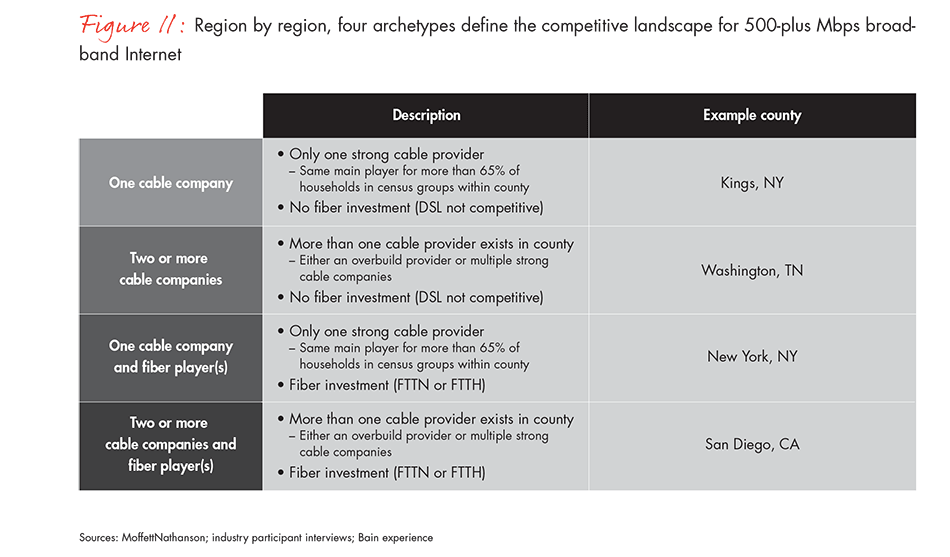
LEO satellite systems could potentially offer connectivity globally at 14 Gbps per beam as soon as 2020. Leading consortia, including Iridium, Google, WorldVu and SpaceX, are working on third-generation LEO satellites. Most are aiming to launch by the end of this decade, and regulations and needed infrastructure already are in place. The main challenges are the cost of satellites and the reliability of launchers.
Total connectivity will enable new digital service models across many sectors, including advanced two-way energy management systems and remote healthcare monitoring and delivery. Instead of getting on a plane to visit world-class clinics and physicians, for example, patients will go to local satellite clinics where they can connect to the same medical experts for a virtual diagnosis and treatment. High-speed satellite communications also will provide the critical real-time communication infrastructure needed for driverless cars.
Transportation efficiency
New technologies enabling autonomous vehicles and delivery drones will make transportation more efficient in the coming decade, lowering costs, especially for the last mile. Driver-assist features, such as highway autopilot and the ability to change lanes automatically, already are commercially available. In late 2015, electric car pioneer Tesla launched a software update enabling a highway-autopilot function on its existing cars, and highway driving will be nearly autonomous by the early 2020s. Fully driverless cars will not be widespread until they are safe under all driving conditions, including rain, snow and extreme sunlight—likely around the second half of the next decade. ABI Research forecasts 9.9% of all cars sold in the US will be self-driving by 2030 (see Figure 12).
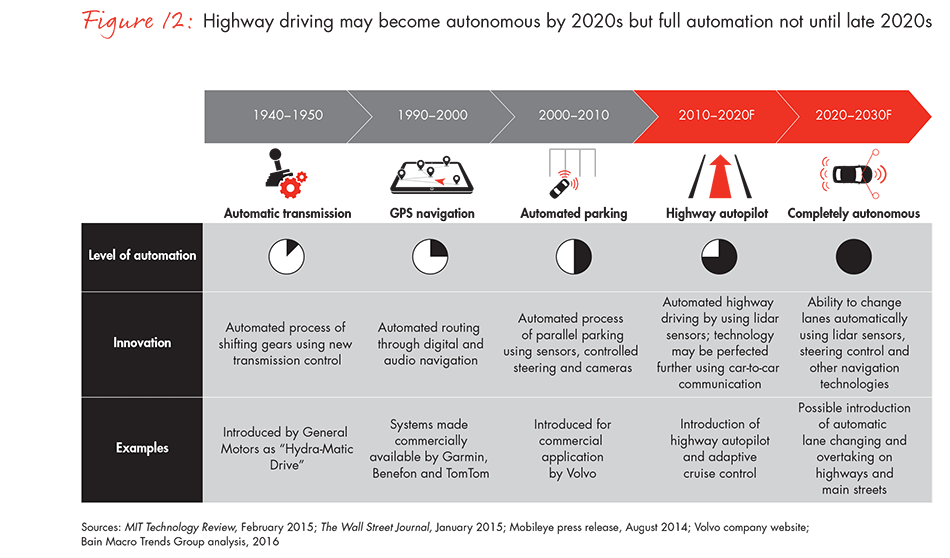
The cost of autonomous driving platforms will be a key factor in market take-up. Lidar sensors used in autonomous cars to measure distance by illuminating a target with a laser and analyzing the reflected light cost $1,300 apiece today. The price is forecast to fall to $150 by next decade. Regulatory issues could also slow adoption rates, although five US states currently allow testing of autonomous cars, and their regulations will likely form the framework for other states over time (see Figures 13 & 14).
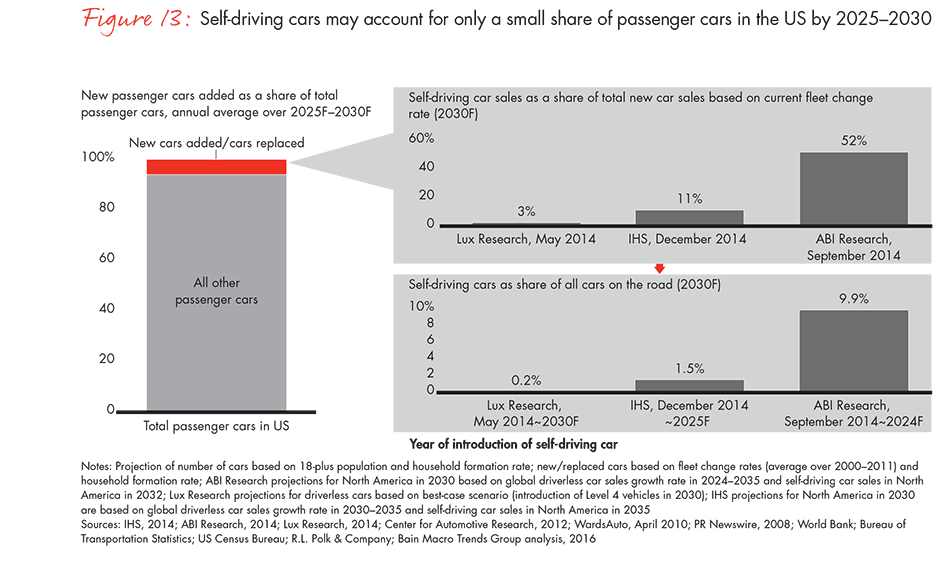
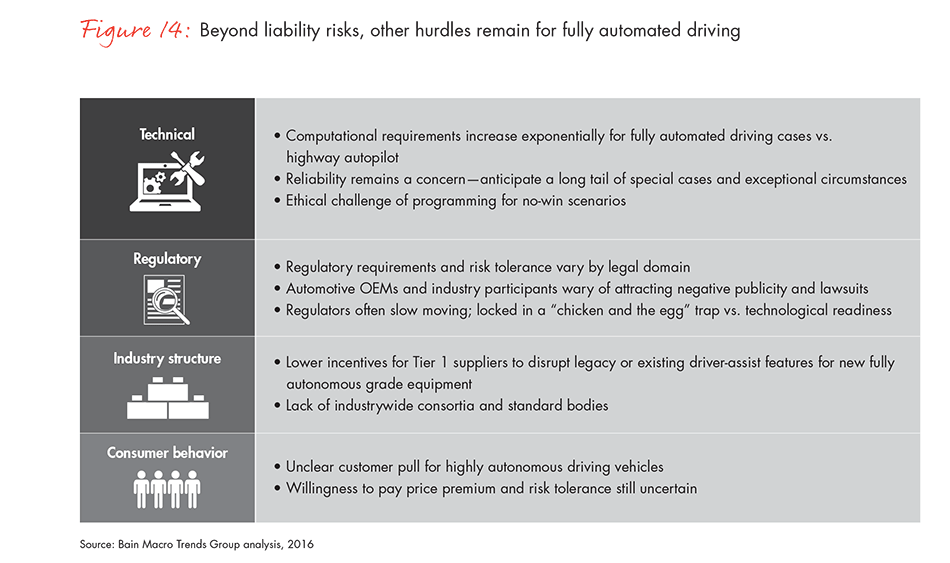
Advances in logistics technology and drones will continue to improve last-mile economics and allow businesses to deliver goods to consumers’ homes faster and at ever-decreasing cost. Drone delivery of a package already costs 75% to 80% less than human delivery. Several companies, including Amazon, Google and DHL, have developed delivery-drone prototypes, but regulatory approvals remain a barrier. NASA is working on an Internet-based system that will manage low-altitude unmanned aerial vehicles, including drones, and the FAA expects to begin full certification of drones in 2020. Globally, Australia and New Zealand already allow more liberal use of drones for commercial activity than the US or Canada.
While driverless cars will reduce the time spent driving to work every day and the cost of distance, only an average 20% of total miles traveled per year in the US are spent commuting. Shopping and errands account for nearly one-third of total miles traveled per year, according to the US Department of Transportation. New commercial delivery services that use both autonomous vehicles and drones, such as driverless UPS trucks with drones that deliver to the last mile, could have an even bigger impact, reducing household transportation time and costs (see Figure 15).
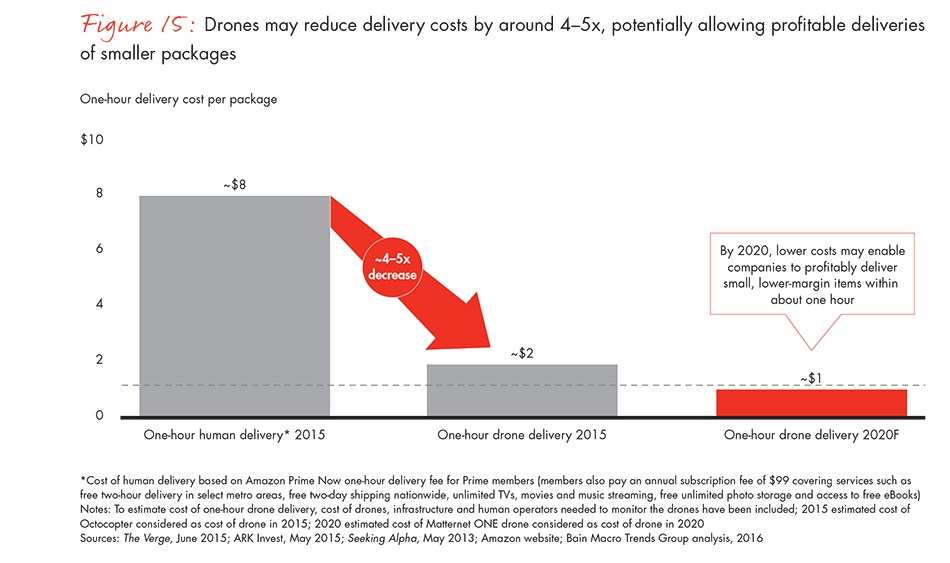
It’s the combination effect that matters
No single technology can shrink the cost of distance. It is the convergence of multiple technology platforms that is laying the foundation for rapid and profound economic transformation. Our research, in fact, shows the advanced economies that have been stalled for a decade or more may now be at the base of a new S-curve of rapid development (see Figure 16).
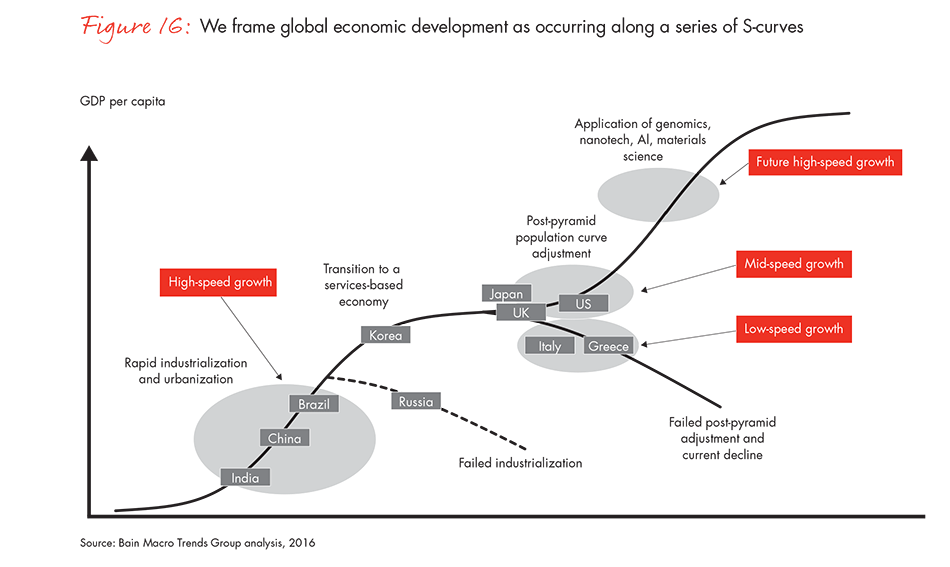
As researchers wield multiple technologies to innovate, they will trigger chain reactions. For example, seven key technologies are coming together to create service sector robots: breakthroughs to enhance sensing, motor control, navigation, mechanized human hand-like dexterity, cognition, battery life and social interaction. In some cases, development is moving forward thanks to multiple applications in sensing and navigation, an area of overlap between robotics and autonomous vehicles, or battery technology that bridges robotics and drone applications. Over time, commercially viable service robots will give rise to microsized semiautomated stores, local customized manufacturing and automated household assistants (see Figure 17).
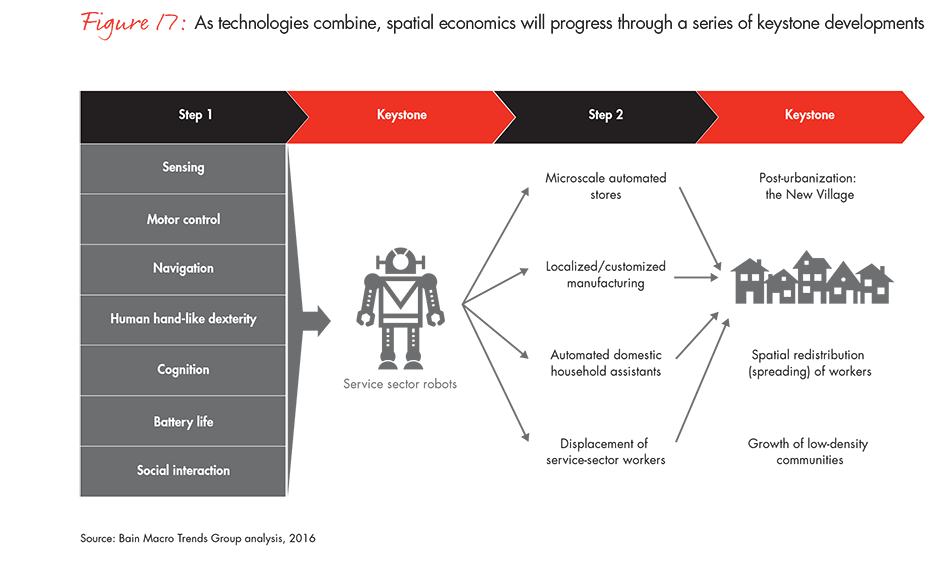
Cross-pollination across core platform technologies will increase over the coming decade, creating new technology chains, some of which are already visible and many of which will be disruptive. For example, researchers linking advances in genomics, biotechnology, artificial intelligence and sensor technologies are pioneering advances in personalized medicine and remote diagnostics. Such technologies have important implications for improving health, longevity and lifetime cost of care, but they also contribute to the declining cost of distance. For instance, routine visits to hospitals or doctors’ offices for consultation, diagnosis and ongoing observation will be replaced by digital exchanges of information.
3. Implications for business and society
The post-urban landscape
Over the next decade, the growth of households in rural and exurban areas vs. in city centers will start to take the shape of a barbell, according to research by Bain’s Macro Trends Group. Some cities will continue to grow successfully, attracting the wealthy, the young and empty nesters. Another segment of households—especially middle-class families—is likely to opt for a big increase in space at lower cost, moving far from city centers. Caught in the middle are the traditional suburbs—the old compromise that is neither spaciously rural nor conveniently urban—and small or medium-sized cities lacking sufficient urban appeal. Both would have to improve their offerings or face decay.
On one end of the barbell will be cities with large walkable urban cores like New York, San Francisco, London and Paris. These urban centers will be inhabited by an affluent cohort able to choose where to live without financial constraints. As large cities compete for residents, industry clusters—like the technology hub in Silicon Valley or the financial sectors in New York and London—will become even more important sources of urban competitive advantage.
The other end of the barbell will include what we call the New Villages—residential zones lying at the furthest edge of the traditional metropolitan commuter belt, more than 50 miles or a 90-minute commute from city centers. The New Village model will blend the most desirable features of rural living, particularly lots of living space at low cost, with many urban amenities. The declining cost of distance will help diminish the gap in goods, services, education and healthcare between densely packed urban centers and the New Village.
In a post-urban economy, it will be even less important to live within commuting distance of an office building, or to relocate for a job. Instead, people will choose where to live based on lifestyle characteristics and amenities, such as good weather, a vibrant social and cultural scene, proximity to recreational activities or extended family.
The migration already has begun. The Bain Macro Trends Group analyzed US Census Bureau data for 360 metropolitan statistical areas, defining the urban center as being 10 miles or less from the city center, about the average one-way commute. In 2000, just under half the US population (49.7%) lived within 10 miles of a city center. But by 2010, shortly after the Great Recession ended and before the more recent restart of exurban migration, that number had fallen to 47.5%.
The 2.2 percentage point decline in urban concentration (spanning a decade in which overall migration paused for nearly five years due to the Great Recession) represents almost 6 million fewer people living in the urban center. (Population figures are based on the subset of the US population covered by the US Census Metropolitan Statistical Areas, about 85% of the total US population.) The outward movement was split evenly between the 11- to 20-mile bracket, traditional suburban commuter belt zones and the 21- to 40-mile bracket, composed of distant suburbs and exurbs often outside the traditional commuter belt.
This finding may seem at odds with reports about resurgence of urban centers, but it is not. The total population living within the city-center radius did increase over the decade by 7 million people, but the population of the US also grew. Had these urban centers retained their proportional share of the population, they would have added 13 million people. Instead, the suburbs and exurbs increased their share by 6 million people.
Putting this 6 million-person movement into historical context highlights what may be in store for cities, suburbs and exurbs in the near future. Our research shows the declining cost of distance has the potential to trigger a major lifestyle shift away from city centers, similar in scope and impact to the US suburban exodus between 1950 and 1980. Based on that scenario, we would expect the move out of US urban centers between 2010 and 2025 to rise to about 6% of the population per decade, or up to 24 million people in total by 2025 (see Figure 18). Overall, US urban centers would see outright declines of more than one-half million people per year (even as winner cities continue to grow), while almost 3 million new residents per year would opt for more space in the exurbs and New Villages.
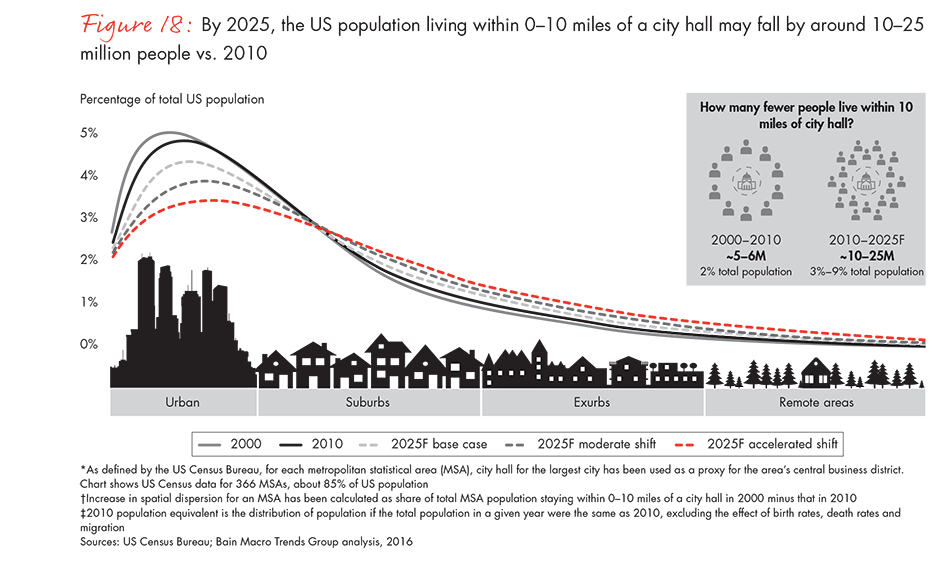
Historical data shows as much as 8% of the total US population has exited urban centers over the course of a decade (see Figure 19). Translated into people terms, the US population in 2025 is expected to be 38 million higher than in 2010, with about 4 million of that increase going to the outermost exurbs. Within a decade, the country’s exurban population may outstrip the urban center population (see Figure 20).
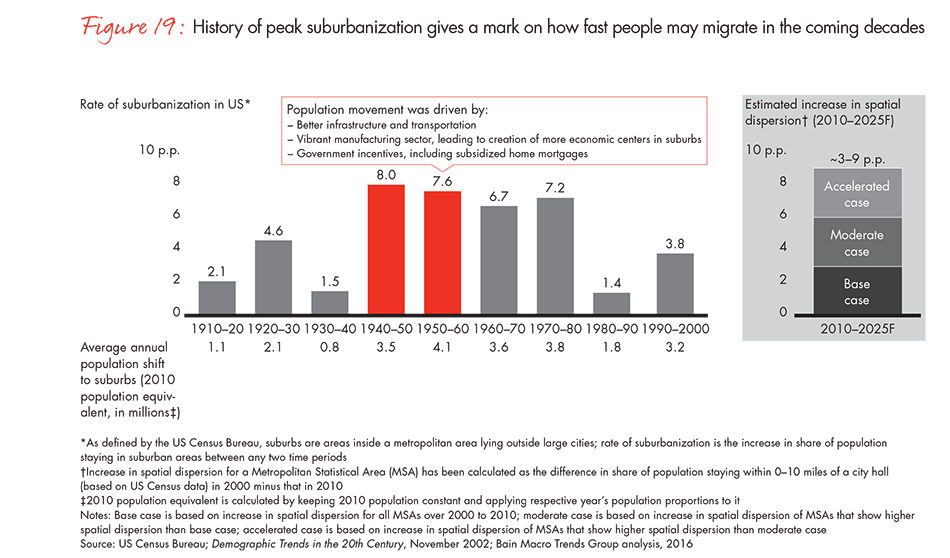
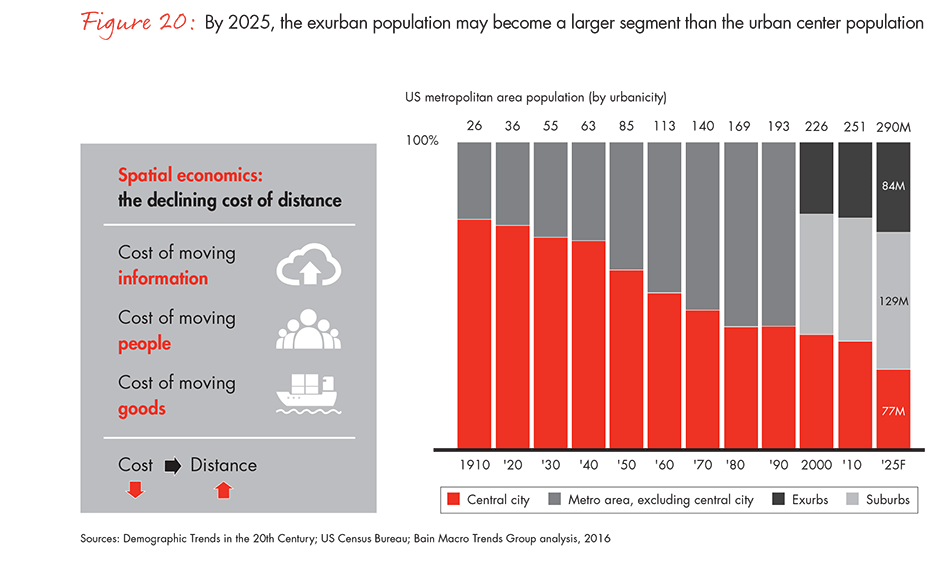
A shift of this magnitude could bring the US housing industry back to its previous peak level of new home construction, also stimulating demand for all the goods and services that go with greenfield developments. Retailers and restaurants on the front line of this shift will have opportunities to address new geographic markets. The challenge will be to serve a more dispersed consumer base economically. Omnichannel capabilities that help retailers interact with customers through different media and create a seamless consumer experience will be critical to navigating this new environment successfully.
Proximity to jobs is still a major consideration for most workers. We expect telecommuting to grow in the coming decades based on technological, generational and workforce changes. Recent data on employment trends since the 2007–2009 Great Recession show more than 80% of the employment growth in the suburbs and exurbs. That data suggests that spatial constraints are already relaxing and employers are in some cases leading the outward movement.
A sampling of European data indicates that the movement away from central cities is even stronger in many parts of Western Europe than in the US. City-level data for cities like Stockholm show the rate of growth of suburbs and exurbs was almost twice that of core cities between 2001 and 2007. During this period, city center and inner suburban London lost more than 100,000 residents (nearly 600,000 domestic residents with a considerable offset due to foreign immigration) while inner and outer exurbs—the ring of counties outside the green belt—added more than 300,000 residents (see Figure 21).
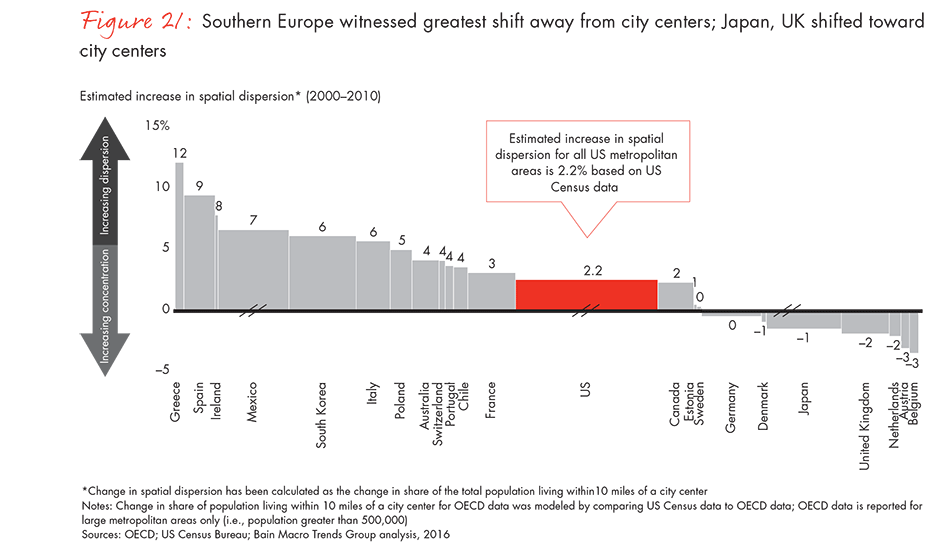
Skyrocketing home prices in London have prompted many to leave the city for less-pricey areas. London’s exorbitant housing costs are in turn an example of global capital superabundance, which has pushed up asset prices (and lowered the cost of capital, enabling cheap mortgages), combined with the UK’s regulatory framework that created accessible global investment in London property. (For more on capital superabundance, see the Bain report A World Awash in Money: Capital Trends through 2020.)
As New Villages multiply, average family size may stabilize or even increase slightly, because greater space at lower cost relaxes the economic pressure to have fewer children. A shift back to multigenerational living in advanced countries may become feasible again, as the declining cost of distance allows middle-class couples to live and work in close proximity to family. That, in turn, could reduce pressure on young couples to pay for childcare and help address the needs of a large, aging and relatively underfunded Baby Boom generation. In other words, spatial economics may also provide solutions to rising costs of aging, child rearing and shrinking populations.
Cities and suburbs will have to contend not only with more attractive exurban and rural developments outside the traditional commuter belts, but also with other cities offering better quality of living. Some urban features are fixed, like climate and natural geography. But other features can be shaped by development initiatives and policy, including civic arts and culture, universities and centers of intellectual capital development, and government regulations and tax policy. These features may become the basis on which cities compete.
The decline of export-led development
The economics of distance will hit the most advanced economies with full force, but its consequences for good and for ill will also reverberate on a global scale, challenging the established model of investment and export-led growth. Why? Breakthroughs allowing industry to operate small-scale manufacturing and service businesses efficiently will dramatically increase local production. In the new world of spatial economics, local producers will serve local demand at a competitive price. That will reduce or in some cases eliminate the advantage of pools of low-cost labor far removed from domestic markets.
As Bain’s Macro Trends Group has noted in prior research (The Great 8 Trillion-Dollar Growth Trends to 2020 and A World Awash in Money: Capital Trends Through 2020), limited demand is constraining global growth. One of the most precious and scarce commodities at a global level is end demand. Countries and regions that generate strong domestic demand—by wealthy consumers in particular—will enjoy economic advantage as local production proliferates. Not only are local producers close to local consumers, they have greater knowledge and ability to customize products.
This change is a sharp deviation from the recent decades in which advantage accrued to the lowest-cost producer. One implication is that the US and Europe will be better positioned for growth than developing countries that provide cheap labor and production. The successful development model of the past half century, export-led growth—including suppressed domestic consumption, cheap labor and high savings rates—worked by finding demand abroad and creating cheap supply at home to serve that demand.
Japan, the Asian tigers and finally China mastered the game for maximum growth. Over time, they replaced cheap exports with higher value-added products, and other developing countries took on the role of producing cheap manufactured goods. As spatial economics change the rules of the game, this model may no longer work well. Instead, countries with strong local demand may rule the day. Those without large pools of middle-class consumers, by contrast, face the prospect of trying to sell manufactured goods to advanced economies with a reinvigorated set of domestic competitors.
Societal implications
Companies also need to brace for deep social, economic and political dislocation.
As in previous periods of disruption, new technologies may displace entire industries. Those without work and adequate skills may be left behind. Governments will face mounting pressures to enable a smooth and equitable transition if they are to avoid repeating the social turmoil that marked other major transformation periods.
Breakthrough technologies also can become victims of their own success. Automobiles brought increased mobility, along with urban nightmares of traffic congestion and pollution. It is not hard to imagine a world where drones become so cost effective, convenient and popular that massive overhead drone swarms become a new form of air pollution. Service robotics may free us from tedious and dangerous tasks to focus on more fulfilling pursuits, but they could also facilitate the ills of physical inactivity, including obesity and diabetes.
Unprecedented connectivity at a global scale also portends unprecedented cybersecurity risk. Already on the rise, cyber criminals have demonstrated their ability to cause crippling disruptions in the physical world. If such attacks impede technology adaptation along any of the vectors we outlined, the rate of decline in the cost of distance could slow.
Finally, physical fragmentation could increase social fragmentation, which may lead to more self-segregated communities. Social inequalities can lead to stark physical separation. A more spatially dispersed society may become a society even more difficult to govern at a national level.
It’s not often that economic change happens all at once on a massive scale, transforming structures, the way business is done and the way services and goods are provided. Our research on the declining cost of distance argues that change will be faster, more expansive and more tumultuous for advanced economies than this generation of business leaders has experienced so far in their careers.
Taking spatial economics to the highest macroeconomic level, the declining cost of distance is part of the much broader Great Transformation, the sweeping outlines of which are just beginning to show up in data and in early commercialization-stage innovations. In addition to spatial economics, Bain’s Macro Trends Group has been studying closely other major parts of the coming Great Transformation, including demographic and lifecycle shifts; changes to capital ownership and capital markets (capital superabundance); changes to labor markets, income and wealth; the emergence of the new smaller business; and geopolitical shifts and disruptions. By 2025, the Great Transformation era will be in full swing, with spatial economics a core element of the transformation.
Karen Harris, managing director of Bain's Macro Trends Group, discusses why companies need to recognize the profound shift in spatial economics.
4. Actions for businesses and investors: Shifting gears for a post-urban world
Beware of impending stranded assets
As millions of people move out of urban centers and settle in New Villages, the value of fixed assets—including real property, such as apartment buildings, shopping centers, telecom fiber and toll roads—may fall sharply in some locations. The risk: Today’s investments become tomorrow’s write-offs. Companies can seek to minimize the risk of such stranded assets by keeping a sharp eye on population migration patterns and looking beyond cyclical economic swings that can mask migration flows.
The declining cost of distance and the dispersion of the population out of city centers will create new opportunities for retailers, restaurants and other businesses. Companies that provide goods and services at multiple locations can review site strategy and evaluate the economics of smaller and more numerous points of presence.
Examine supply, distribution and logistics chains for opportunities to strip out distance costs
The substitution of capital for labor in manufacturing will make it possible to produce economically closer to the end-market, but distribution may need to be more dispersed in order to synchronize more tightly with increasingly diverse needs and tastes. Leadership teams can assess whether supply chains are vulnerable to a sharp decline in the cost of distance and experiment with alternatives that offer a lower net distance cost. They also can review the future need for large-scale production or warehouses vs. multiple smaller locations. Finally, companies can consider converting physical movement to electronic movement (for example, 3-D printing prototypes).
Test and learn: Experiment to identify the key pinch points of spatial economics
Leadership teams can put themselves on the front lines of the transformation by starting now to incorporate new technologies such as robotics, 3-D printing and drones into their workflows. Not every bet will pay off, but the experience of testing and learning will help position early movers to benefit as the transformation accelerates. Why start now? Most businesses will need time determine how to best make use of new technologies. Forerunners will experiment with these new technologies even if they aren’t flawless.
Stay alert to the migration of human capital and talent
Spatial freedom will pool talent in some locations, drain it from others and generally disperse it more widely than in the past. Depending on the specific talent and human capital needs of each business, this shift may require rethinking the core locations for centralized business functions. Teams of the future may no longer be located together. However, geographical clusters—such as London or New York for financial services, or Silicon Valley and Boston for technology—will become more important. Businesses will need to embrace tools to help enable seamless virtual collaboration at all levels. Equally important, they will need to adjust culture and corporate tradition where it stands in the way of adaptation to a new era.
Canvass the growing number of investment opportunities taking shape
To be among the first to spot trends, stay abreast of enabling technologies. What’s important is the pace at which they are adopted and combined, triggering new developments. Some of the investment themes emerging from spatial economics include:
- businesses that solve the “last-mile issue” of getting goods and services to the final user (transportation efficiency);
- investments in other enabling technologies, including service robotics and connectivity;
- housing growth in exurbs and consumer-oriented services and businesses to serve new greenfield communities;
- technology to support small-scale manufacturing and the host of automation technologies required to take the physical consumer experience in stores and restaurants to much lower minimum scale points; and
- service-sector productivity improvements to bring the minimum scale points down for the provision of consumer services.
Most companies have not begun to think about the declining cost of distance or calculate its impact on their business—but the transition to a new economic era has begun. The good news is that there is still time to adapt and brace for disruptive change. Leadership teams that start preparing now will be best positioned to minimize the risks and make the most of the opportunities as the transition accelerates.
This work is based on secondary market research, analysis of financial information available or provided to Bain & Company and a range of interviews with industry participants. Bain & Company has not independently verified any such information provided or available to Bain and makes no representation or warranty, express or implied, that such information is accurate or complete. Projected market and financial information, analyses and conclusions contained herein are based on the information described above and on Bain & Company’s judgment, and should not be construed as definitive forecasts or guarantees of future performance or results. The information and analysis herein does not constitute advice of any kind, is not intended to be used for investment purposes, and neither Bain & Company nor any of its subsidiaries or their respective officers, directors, shareholders, employees or agents accept any responsibility or liability with respect to the use of or reliance on any information or analysis contained in this document. This work is copyright Bain & Company and may not be published, transmitted, broadcast, copied, reproduced or reprinted in whole or in part without the explicit written permission of Bain & Company.
Acknowledgements
The authors express their appreciation to the many members of Bain & Company who provided insights for this report, including James Allen, Jennifer Binder-Le Pape, Lars Jacob Boe, Chris Brahm, Herbert Blum, George Cogan, David Crawford, Lucy Cummings, Marc Eames, Toshihiko Hiura, Ron Kermisch, Mike McKay, Niels Peder Nielsen, Dave Sanderson, Michael Schallehn, Velu Sinha, Paul Smith, Suzanne Tager and Gary Turner. The authors express their gratitude for research support provided by our team at the Bain Capability Center, led by Manishita Mishra: Rohit Chadha, Dhruv Bathla, Pranjal Kalra, Noopur Kamal, Paridhi Mutreja, Nishant Nair and Shreya Padiyar.
They also thank Gail Edmondson and Paul Judge for their editorial support.




















